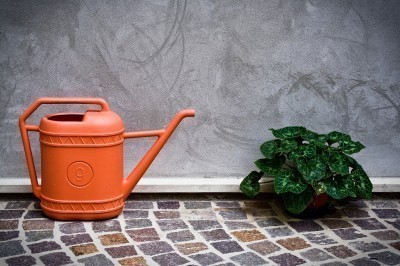






If you don’t water your plants, they will die. It’s a very simple fact. However, they deteriorate also if you water them too much. Their compost becomes soggy and airless, so the roots of the plant suffocate. You want to set your goal of watering to providing your plants with adequate water only when they need it. In the summer, your houseplants will need more water than they will in winter. However, you need to keep the compost moist in winter months.
There are several ways to determine when your plants truly need water. First, if you rub your thumb on the surface of the compost, you can tell if the plant needs water. Using this method, you only want to water when the compost feels dry and has no sponginess left.
You can tap on clay pots with a cotton reel attached to a pencil. A dull note will tell you the compost is moist. If it rings instead, you should water that plant.
You can use moisture-indicator strips. All you do is insert them into the compost and leave them. They turn color when the compost is dry so you will know when to water.
Finally, they sell moisture meters. These have a thin, pencil-like probe that you push into the compost to measure the moisture level on a dial. These are pretty efficient, but if you repeatedly use the meter, the probe can damage the roots.
The most used way of watering houseplants is by letting water dribble out of a small watering can straight onto the compost. This is known as “over the rim” and the goal is to fill the space above the compost to the rim of the pot with water.
Another way of watering would be to set the pots in bowls of water and let the plant “drink” what it needs. When you remove the pot from the bowl of water, all excess water will drain away. Air plants (such as Tillandsias) should be misted. Misting means soaking the plant’s leaves with water. Others are watered by filling their little flower or leaf cups up with water.
Most people lovingly look after their houseplants throughout the year. These same loved plants deteriorate and die when their loving people go on vacation, leaving them to their own accord for weeks at a time. Remember that it’s often better to rely on some sort of automatic watering system than a neighbor. Neighbors get busy.
Your large plants can be left in their saucers but place them on plastic sheeting in a lightly shaded room. During the week before you leave for vacation, water them several times. If your vacation is only a week to ten days, your plants will be alright during that time.
Small plants can be put into large trays with 1cm of water in the base. This will keep them alive for a while if you set them down in a lightly shaded room. You could also put a capillary mat on a draining board and trail one end of the mat into a sink filled with water. The other end of the mat can be put into a bowl of water and you would then place your plants on the mat. This works best for plants in plastic containers filled with peat-based composts.
You can sometimes save plants that have not been watered. Plants that are under watered usually wilt and then eventually die. Once a plant is wilting, a time comes when no matter how much water you give it, you cannot save it.
Some of the time, though, you can revive a wilted plant. Set the pot in a bowl with 3-4 cm of water in it. Then prune the plant by removing faded flowers and mist the leaves. When moisture rises to the surface of the compost, take the plant out of the bowl and place it in light shade for a day or two.
If your compost becomes completely saturated with water, especially from over watering, there is no air for the roots of the plant and it will wilt, the leaves becoming limp. A slime will cover the compost. If you notice this early enough, you can fix it. Take the pot and turn it over. Slip the root ball out of the pot. Wrap several pieces of paper towels around the root ball to soak up some of the water. Remove any root mealybugs. Leave the root ball wrapped like that until it is almost dry.
When it’s almost dry, you can repot the plant into a clean pot with fresh compost. Leave it along for a few days before you water it. Remember, it was just soaked! Don’t place this plant in direct sunlight until you know it’s completely healed.
Taking care of your plants isn’t difficult if you just pay attention to their needs. You will reap the rewards in the long run by having lush plants to decorate your home with.
Copyright © www.100flowers.win Botanic Garden All Rights Reserved